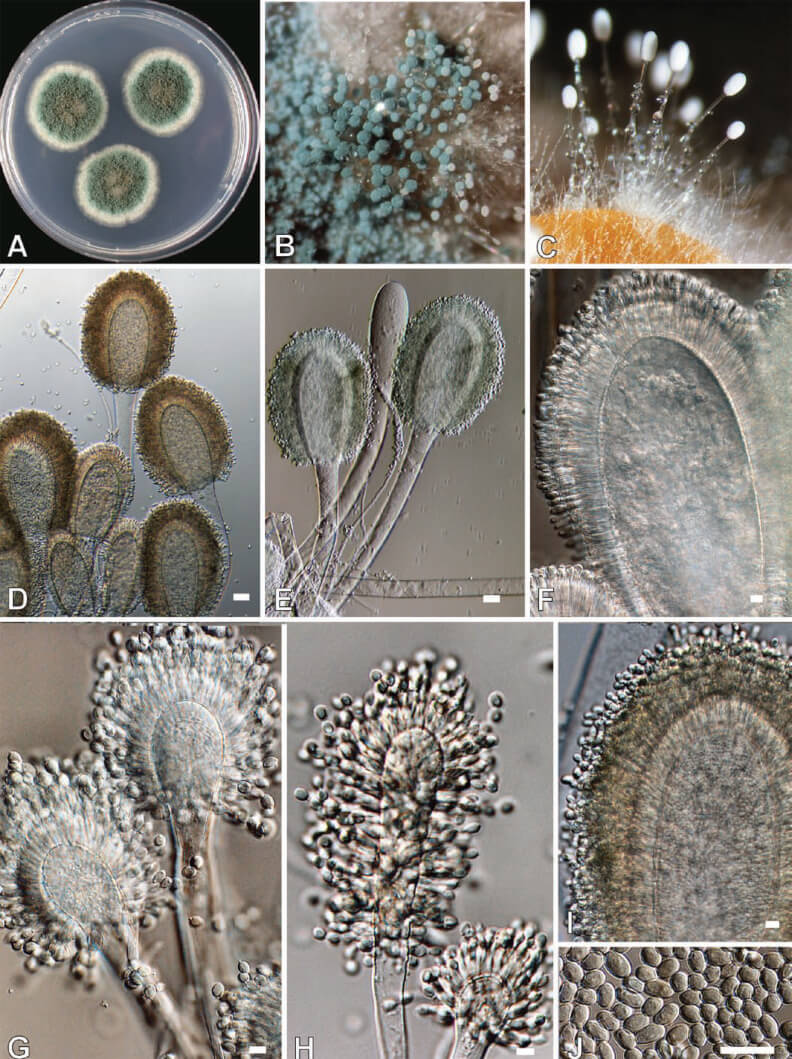Overview of Aspergillus clavatus
Aspergillus clavatus is a pathogenic fungus that produces mycotoxins (toxic compounds), leading to severe pulmonary diseases like Malt's worker’s lung. The tiny conidia (spores) circulate in the air and, when inhaled, can trigger allergic reactions. These reactions are particularly severe in immunocompromised (weakened immune system) patients.
Habitat and Distribution
Aspergillus clavatus thrives in humid environments with temperatures ranging from 5°C to 42°C. It is commonly found in soil, especially in cultivated fields with crops like barley, potatoes, and cotton. This fungus is also present in stored cereals like rice, corn, and millet, particularly in moist conditions.
Morphological Characteristics
This fungus grows rapidly, forming a velvety, bluish-grey green felt. The conidia are produced asexually and are arranged in a columnar form. The conidiophores (spore-producing structures) are smooth, colorless, and can reach up to 3 mm in length. The conidia are club-shaped (thicker at the apex) and measure about 3.0 – 4.5 x 2.5 – 3.5 μm.
Examples
- Aspergillus niger (Black Mold)
- Penicillium chrysogenum (Green Mold)
- Rhizopus stolonifer (Bread Mold)
Cultural Characteristics of Aspergillus clavatus
On Czapek’s Solution Agar
Aspergillus clavatus grows rapidly on Czapek’s solution agar, forming colonies of 3.0–3.5 cm in diameter at 24–26°C within 8–10 days. Colonies appear plane or slightly furrowed with a floccose (woolly) surface and thin mycelium. Conidiophores are initially colorless but turn brown over time.

Conidiophore and Conidia Characteristics
The conidiophores of Aspergillus clavatus are erect and grow up to 1.5–3 mm long with a 20–30 μm diameter. They feature an enlarged, clavated (club-shaped) vesicle 200–250 μm long and 40–60 μm wide. Young conidia are large-headed (300–400 μm by 150–200 μm), maturing into greenish olive chains.
On Malt Extract Agar
On Malt extract agar, Aspergillus clavatus colonies develop differently. Conidial structures are smaller, and conidiophores are weakened and tiny, measuring 300–500 μm. Colonies grow within 6 days and emit a strong, unpleasant odor.

On DG-18 Agar
Aspergillus clavatus colonies on DG-18 agar also differ in appearance, showcasing unique growth patterns. Refer to the source for visual details on DG-18 agar colonies.
Life Cycle of Aspergillus clavatus
Aspergillus clavatus reproduces asexually. Conidia (spores) disperse into the environment from the conidiophores. Upon landing in moist conditions between 25°C–42°C, they germinate, forming elongated, branched somatic hyphae. These hyphae develop into conidiophores with a vesicle from which phialides (spore-producing cells) extend, producing conidia in chains.
Pathogenesis of Aspergillus clavatus
Aspergillus clavatus is less pathogenic than other Aspergillus species but can be allergenic. It produces millions of tiny spores that are inhaled without causing disease in healthy individuals. However, those with mold allergies or weakened immune systems are at risk.
Allergic Aspergillosis
This condition is an IgE hypersensitivity reaction to fungal spores (tiny reproductive units) of Aspergillus clavatus. Repeated exposure leads to a hypersensitivity immune response, causing lung diseases, airway issues, and digestive problems if ingested.
Pulmonary Aspergillosis
This involves an excessive inflammatory response to hyphae (fungal filaments) colonizing the sinopulmonary tract. Symptoms range from impaired lung function to severe reactions.
Malt Workers’ Lung
An occupational disease affecting farmers working with barley. Barley releases spores during brewing, leading to Malt worker’s lung disease. Symptoms vary from acute coughing and chest tightness to chronic respiratory distress if untreated.
Nail and Skin Infections
Patulin toxicity from consuming contaminated apples and other fruits can cause gastrointestinal issues and respiratory problems. Severe exposure can lead to neurotoxicity, including convulsions and neurological deficits.
Mycotoxins Produced
Aspergillus clavatus produces several mycotoxins, including patulin (found in rotten apples) and cytochalasin E (prevents blood vessel formation). These can cause serious illnesses and are toxic when ingested or inhaled.
Laboratory Diagnosis of Aspergillus clavatus
Specimens: Sputum, bronchial wash, and bronchoalveolar lavage.
Culture:
- Czapek’s solution agar: Produces greenish colonies with distinct morphologies.
- Malt extract agar: Produces a sharp fungal smell and poor morphology.
Microscopic Observation:
- Transmission electron microscopy: Observes phialide development and conidia formation.
- Simple electron microscopy: Shows continuous walls of conidia and phialide.
Molecular Detection:
- DNA analysis for quantification of GC-content (a measure of DNA sequence).
Biochemical Examination:
- Identifies soluble carbohydrates like mannitol and arabitol in the conidia’s cell wall.
Treatment of Aspergillus clavatus Diseases
Pulmonary Aspergillosis: Treated with itraconazole and amphotericin B (antifungal medications).
Allergic Aspergillosis: Managed with anti-allergens and anti-inflammatory drugs.
Malt Workers’ Lung: Treatment is challenging; anti-allergies and corticosteroids may help reduce symptoms.
Prevention and Control
- Minimize mold exposure by removing sources.
- Use protective clothing, such as face masks, for workers.
- Treat damp household surfaces with antiseptics to reduce fungal spores, especially in homes with immune-compromised individuals.
Examples of Scientific Names and Local Names:
- Aspergillus niger (Black mold)
- Aspergillus fumigatus (Green mold)
- Aspergillus flavus (Yellow mold)









Comments